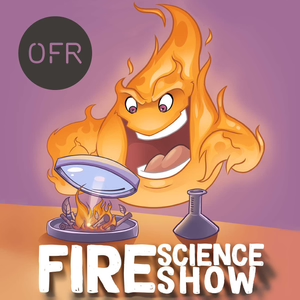
Fire Science Show
Wojciech Wegrzynski
All episodes
Best episodes
Seasons
Top 10 Fire Science Show Episodes
Goodpods has curated a list of the 10 best Fire Science Show episodes, ranked by the number of listens and likes each episode have garnered from our listeners. If you are listening to Fire Science Show for the first time, there's no better place to start than with one of these standout episodes. If you are a fan of the show, vote for your favorite Fire Science Show episode by adding your comments to the episode page.

171 - Exploring Water Mist Systems with Max Lakkonen
Fire Science Show
10/02/24 • 52 min
I approach modelling water mist with caution. Not that I don't understand it, but because I lack clarity in the goals and objectives, as well I'm usually aware I may not deliver the expectations of my clients in terms of the physical phenomena I am capturing... And I'm not the only one like this. In this podcast episode I explore the world of water mist with Dr Max Lakkonen from IFAB, who has just been chosen as the new President of the International Water Mist Association (IWMA),
Max dives into the history and evolution of water mist technology, explaining how a catastrophic fire on a Scandinavian Star Cruise liner 35 years ago led to its commercial introduction. Discover why understanding droplet size is crucial for optimising water mist systems and why it's important to understand these systems with a clear understanding of objectives to achieve effective fire safety solutions.
Max discusses the necessity of extensive experimental testing to account for different nozzle types, pressures, and flow rates, highlighting the complexity involved in designing these systems. We also touch on the importance of industry collaboration and the role of organizations like IWMA in bridging the gap between specialized water mist companies and fire safety engineers, ultimately ensuring the dissemination of crucial information and best practices.
Dive into the intricacies of CFD modelling in fire safety engineering, especially for water mist systems. Max brings to light the limitations of relying solely on CFD without experimental validation and the benefits of using CFD for preliminary studies to save both time and costs. We address the unique challenges of modelling cooling effects, fire suppression in tunnels, and the need for best practices and guidelines in fire safety engineering. Listen in to gain valuable insights from one of the leading experts in the field and understand why practical application often trumps academic theory in real-world fire control scenarios.
Most importantly, the CFD Position Paper we have promised to you is available to download now!!!
Make sure to visit the International Water Mist Association site for more resources and the necessary connection with the industry.
The cover image was captured at the Baltic Fire Laboratory during ITB-FRISSBE Summer School. If you want to see it live, pay attention to our announcements on LinkedIn, and perhaps we can see each other next summer!
----
The Fire Science Show is produced by the Fire Science Media in collaboration with OFR Consultants. Thank you to the podcast sponsor for their continuous support towards our mission.
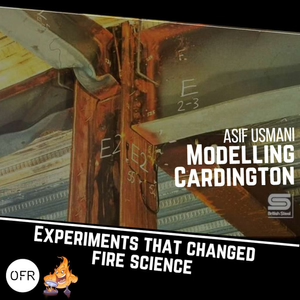
131 - Experiments that changed fire science pt. 8 - Modelling Cardington Fire Tests with Asif Usmani
Fire Science Show
12/06/23 • 51 min
In this part 8 of Experiments that changed fire science series we revisit Cardington (previously covered in part 2 - https://www.firescienceshow.com/078-experiments-that-changed-fire-science-pt-2-bre-cardington-with-tom-lennon/), but this time from the perspective of modeling the structure. My guest prof. Asif Usmani of the HK PolyU takes us on how simplifying the model led them to some fundamental discoveries on the thermo-mechanical response of structures to fires.
We discuss material properties and perhaps their overestimated role in structural modelling. We go into membrane actions and the role of restraints in shaping the response of beams and slabs to thermal loads. And Asif explains to me what this means at a scale of a building frame. Some truly remarkable insights - things that today are perhaps obvious to any structural engineer, but at that time were an unknown fire behaviour.
Here are some links to the papers related to today's episode:
Cardington
https://www.sciencedirect.com/science/article/pii/S0379711201000376
https://www.sciencedirect.com/science/article/pii/S0143974X01000049
https://www.sciencedirect.com/science/article/pii/S0379711204000116
WTC
https://era.ed.ac.uk/handle/1842/1562
OpenSees
https://link.springer.com/article/10.1007/s10694-021-01184-0
https://www.researchgate.net/profile/Xu-Dai-4/publication/283796522_OpenSees-based_integrated_tool_for_modelling_structures_in_fire/links/5647a6b108ae451880ac4f18/OpenSees-based-integrated-tool-for-modelling-structures-in-fire.pdf
Picture credit: British Steel, after "Newman G, Robinson JT and Bailey CG, Fire safe design: A new approach to multi-storey steel-framed buildings, The Steel Construction Institute, Berkshire, 2006"
Accessed through: https://www.researchgate.net/publication/303531122_Shear_panel_component_in_the_vicinity_of_beam-column_connections_in_fire [accessed Dec 06 2023].
----
The Fire Science Show is produced by the Fire Science Media in collaboration with OFR Consultants. Thank you to the podcast sponsor for their continuous support towards our mission.
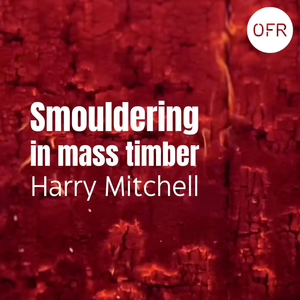
141 - Smouldering in Mass Timber with Harry Mitchell
Fire Science Show
02/28/24 • 51 min
This week, I am meeting up with Imperial Hazelab's Harry Mitchell, who is finalizing his PhD thesis on mass timber fires and, quite uniquely - including the smouldering phenomena in those fires.
As a part of Code Red experiments run by Arup, Imperial College London and Cerib (which you can learn more about from episode 111 with Panos Kotsovinos) Harry has performed observations of formation, growth and decay of smouldering "hot spots" for up to 2 days after the fire. Based on that, conclusions were formed on the occurrence and persistence of the smouldering in large, open-plan mass timber compartments. This is precisely what we cover in this podcast episode - what is the smouldering fire of timber? Where can we expect it to happen? What are the potential consequences to the structure and people who need to enter it (firefighters and investigators?)
If you would like to learn more, please follow to these resources:
- Structural hazards of smouldering fires in timber buildings
- Flame spread characteristics in large compartments with an exposed timber ceiling
- Review of fire experiments in mass timber compartments: Current understanding, limitations, and research gaps
- Fire dynamics inside a large and open-plan compartment with exposed timber ceiling and columns: CodeRed #01
- Impact of ventilation on the fire dynamics of an open-plan compartment with exposed timber ceiling and columns: CodeRed #02
- The Effectiveness of a Water Mist System in an Open-plan Compartment with an Exposed Timber Ceiling: CodeRed #03
And other mass timber experiments covered in the Fire Science Show.
Fire Science Show is produced in partnership with OFR Consultants.
----
The Fire Science Show is produced by the Fire Science Media in collaboration with OFR Consultants. Thank you to the podcast sponsor for their continuous support towards our mission.
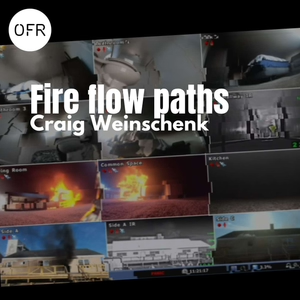
114 - Ventilation and fire flow paths with Craig Weinschenk
Fire Science Show
08/15/23 • 56 min
Most fire engineers would be aware of how openings like doors and windows, the stack effect, and even wind can significantly alter fire outcomes. But there is a considerable difference between knowing that it does, and knowing how much that changes fire growth, size and the internal building environment. I've invited FSRIs dr Craig Weinschenk to discuss his years of full-scale research on fire flows.
In this episode, we discuss different conditions that occur once the flow is established at windows, doors or through HVAC systems. How it affects the fire's growth and spread, and what firefighters need to consider when taking decisions on venting a burning building. We underscore the importance of compartmentalization, discussing how a simple action like leaving a door open can drastically impact fire behaviour and smoke movement.
Although it is a side topic in the episode, perhaps a very interesting discussion is on the battery-initiated fires, discussing the various failure modes that can trigger an overpressure event or a jet flame. We also explore what batteries change in the fire environment when they are victims and participants of the fire (rather than the source). I know many will be interested in this, here is also a good read by Craig on the subject.
As with every episode with FSRI, there is A TON of resources to go through. Our recommendations:
- Public live stream of a fire experiment similar to the one I was invited to watch - this is the same series of experiments in the exact same building
- Search and rescue training course
- FSRI Materials Database
- Github - materials
- Github - public repositories
----
The Fire Science Show is produced by the Fire Science Media in collaboration with OFR Consultants. Thank you to the podcast sponsor for their continuous support towards our mission.

012 - Science, Industry, Legislators. How do we make them work together on a fire safe world? - Kees Both
Fire Science Show
08/04/21 • 74 min
In this episode, I had the pleasure and privilege to host dr Kees Both, the Technical Manager of Standards & Regulations in Etexgroup. Kees wanted to become a suspension bridge engineer, but his route went through a fire lab, and as he said - once you go into a fire lab, there is no way out. From a scientist, he has "evolved" into a research manager, project manager and someone, who has a significant impact on the shape of the standards and legislation in Europe. Kees is also the former President of SFPE Europe.
Due to his unique background, I've asked Kees some important questions related to the state of modern fire science, industrial research and development and legislation. We (attempt to) focus our discussion on how these puzzles play together, and how people representing these roles can and should interact... but we also venture into the wonderful world of tunnel fire safety, obtaining funds for major research projects in EU and how to educate the new generation of fire technicians and engineers. Also, why do pubs play a critical role in fostering healthy discussions between fire safety professionals?
This was certainly one of the most fun discussions I've had in a while, and I hope you will enjoy it as well. Even though it may not have a direct impact on your everyday work or research, the matters brought up in this talk will definitely affect your future in one way or another. The importance of passion in fire engineering and being open to other professionals, also these representing completely different roles, is critical for building a fire safe world, together.
----
LinkedIn Discussion Thread:
https://www.linkedin.com/posts/fire-science-show_environment-innovation-research-activity-6828586364817203200-Q28i
----
The Fire Science Show is produced by the Fire Science Media in collaboration with OFR Consultants. Thank you to the podcast sponsor for their continuous support towards our mission.

01/29/25 • 61 min
If we truly want to account for the population at a disadvantage in evacuation, there is only this much we can do with the current approach... Pre-evacuation time distributions, walking speeds, and so on only tell us a part of the story - the story of your average person within an average population, with an average walking speed and average response. While these models are undoubtedly useful in engineering, there is perhaps a better way.
My friend and guest Enrico Ronchi is trying to find this way through his new ERC Consolidator grant, "Egressibility: a paradigm shift in evacuation research". In this grant, instead of following the main path, he is focusing on stuff we do not know - how to characterise disabilities and understand them better (also through the lens of health and medicine), how to quantify the disadvantages at large, and how to solve potential issues for those who those at the largest risk.
In this episode, you will learn about Enrico's ideas and the edge of the knowledge we have today. Some key points covered are:
• Insights on paradigm shifts in evacuation science
• Introduction of the concept of "egressibility"
• Importance of understanding functional limitations in emergencies
• Shift from agent-based models to inclusive data-driven models
• Use of technology, like VR, for immersive research experiences
• Need for changes in regulations for better evacuation safety
You may also like to read the paper by Guylène Proulx, which introduced egressibility as a concept - available here.
----
The Fire Science Show is produced by the Fire Science Media in collaboration with OFR Consultants. Thank you to the podcast sponsor for their continuous support towards our mission.
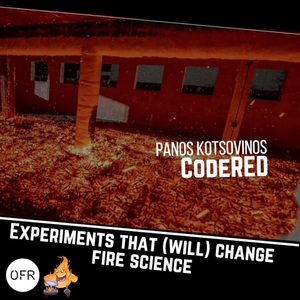
111 - Experiments that will change fire science pt. 7 - CodeRed with Panos Kotsovinos
Fire Science Show
07/26/23 • 63 min
In this week's series covering experimental fire science, we venture into a recently finished Code Red project by ARUP, led by my today's guest Dr Panos Kotsovinos. The project was carried out in CERIB with the collaboration of the Imperial College London. History will tell if this experiment will change fire science, but I truly believe it is at least worth sharing!
The research was carried out on a large open-plan office (350m2) with a combustible CLT ceiling. It was a continuation of previous X-One and X-Two experiments on travelling fire behaviour carried out by Imperial College London in Poland (referred to here as the "Obora" experiments, listen to episode 27 of the show) but with an important difference - this time the ceiling was combustible. They were looking into how the introduction of the combustible ceiling will change the travelling fire behaviour, investigating variables such as the opening factor, the introduction of a low-pressure water mist system and partial encapsulation of the ceiling. The findings include observations related to fire spread, persistent smouldering fires, effects of the partial encapsulation and many many more which are discussed in detail in the show.
To learn more, please read the press release about the experiments here and most important - the papers:
- Fire dynamics inside a large and open-plan compartment with exposed timber ceiling and columns: CodeRed #01
- Impact of ventilation on the fire dynamics of an open-plan compartment with exposed timber ceiling and columns: CodeRed #02
- The Effectiveness of a Water Mist System in an Open-plan Compartment with an Exposed Timber Ceiling: CodeRed #03
- Impact of partial encapsulation on the fire dynamics of an open-plan compartment with exposed timber ceiling and columns: CodeRed #04
- Review of fire experiments in mass timber compartments: Current understanding, limitations, and research gaps
- Structural hazards of smouldering fires in timber buildings
- Flame spread characteristics in large compartments with an exposed timber ceiling
If you have any further questions to Panos please let me know, and I will gladly pass them on to him!
Fire Science Show is produced in partnership with OFR Consultants.
----
The Fire Science Show is produced by the Fire Science Media in collaboration with OFR Consultants. Thank you to the podcast sponsor for their continuous support towards our mission.
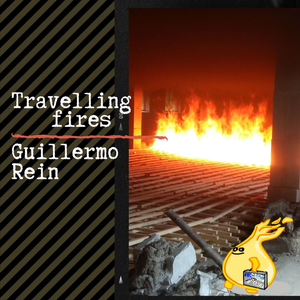
027 - Travelling fires with Guillermo Rein
Fire Science Show
11/17/21 • 65 min
If you have ever learned about the compartment fire dynamics framework, have tried zone modelling or any kind of fire modelling, you have probably noticed that as the compartments get bigger, the less uniform conditions inside are. At some size, the flashover or a "single-zone" model theories just break, MQH equation does not give a reasonable solution and the fire seems not capable of growing to a huge size... But yet, they destroy buildings. Local fire exposure may be damaging to structural elements in the same way as a flashover is. And that is how we considered it for many years...
But there was a gap. Something between a localized fire and a flashover'd fire. For many years we've seen it, but we have not acknowledged it fully untill it was given a name - the Travelling Fire. In today's episode, I have invited prof. Guillermo Rein of Imperial College London, to tell us the origin story, recent developments and future plans related to this methodology. This should be interesting to all - from fire scientists to engineers. IMHO, a well invested hour of your time!
Make sure to connect with Guillermo on socials:
- Twitter
- LinkedIn
and with his group - Imperial Hazelab (also on Twitter).
Guillermo has published 200 research papers, and among them many landmark pieces on travelling fires that I recommend:
- Travelling fires for structural design (2012) with J. Stern-Gottfried
- Improved formulation of Travelling Fires (2015) with E. Rackauskaite et al.
- Improved Travelling Fire Methodology - iTFM (2017) with E. Rackauskaite
- Computational analysis of thermal and structural failure criteria of a multi-storey steel frame exposed to fire (2019) with E. Rackauskaite et al.
- Flame extension and the near field under the ceiling for travelling fires inside large compartments (2020) with M. Heidari et al.
- Fire Experiment Inside a Very Large and Open-Plan Compartment: x-ONE (2021) with E. Rackauskaite et al.
- Thermal Response of Timber Slabs Exposed to Travelling Fires and Traditional Design Fires (2021) with F. Richter et al.
and some many more... You may also be interested in the relevant PhD thesis:
- Jamie Stern-Gottfried (2011)
- Egle Rackauskaite (2017)
And some other work related to travelling fires carried across the world:
- RK Janardhan and S Hostikka When the fire is spreading and when it travels?
- X Dai et. al. Extended Travelling Fire Methodology
- D Hopkin Testing the single zone structural fire design hypothesis
- C Maluk
----
The Fire Science Show is produced by the Fire Science Media in collaboration with OFR Consultants. Thank you to the podcast sponsor for their continuous support towards our mission.

008 - Zone modelling is not dead with Colleen Wade
Fire Science Show
07/07/21 • 53 min
Zone modelling is a technique introduced in 1970's and 80's that has changed fire science. In my personal opinion, along with oxygen calorimetry and the development of FDS it may have been the most impactful tool of fire science. This is why I think its shameful it does not receive the same recognition today.
With Colleen we go deep into the zone models, discussing the tool itself and the ways to adapt it to current needs. You will learn how zone models evolved, and what makes them really useful in the modern world. It is a technology of the past, but certainly one with a bright future.
*** A mandatory download ***
https://www.branz.co.nz/fire-safety-design/b-risk/
This is the zone model largely developed by Colleen, absolutely worth your time to try it out!
--- LinkedIn discussion thread ---
https://www.linkedin.com/feed/update/urn:li:activity:6818412552368771072
--- Useful links ---
https://fireresearchgroup.com/ FRG is the company that Colleen works for, and it is a bunch of great experts solving issues of modern fire science. Excellent resources are available. Keep an eye on them.
Branzfire / B-Risk technical documentation covers the basics of zone modelling, available at: https://www.branz.co.nz/fire-safety-design/b-risk/
The same I can tell about the CFAST documentation, available here: https://pages.nist.gov/cfast/index.html
The paper that made Colleen pursue the career in fire! https://www.sciencedirect.com/science/article/abs/pii/0379711284900067?via%3Dihub
i was wrong in the interview, it is not the one about RSET (that was another by Leo Cooper in the same year, wow, what a brilliant mind he was!)
----
The Fire Science Show is produced by the Fire Science Media in collaboration with OFR Consultants. Thank you to the podcast sponsor for their continuous support towards our mission.
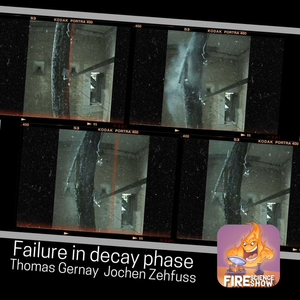
079 - Timber columns failure in the decay phase with Thomas Gernay and Jochen Zehfuss
Fire Science Show
12/07/22 • 47 min
When the flaming combustion stops and the raging inferno disappears, the environment is still far away from a stable, stationary state. The heat emitted by the fire and accumulated by the structural elements is still on the move, travelling through the members until it gets eventually dissipated. As parts of the structure get heated, some processes will occur, that may influence their load-bearing capacity and other properties. This is nothing new, we recognize this as an obvious process within the so-called "decay" phase of the fire.
What is new, though, are some recent observations related to the behaviour of timber elements in this phase of the fire. Today's guests Thomas Gernay and Jochen Zehfuss (along with a team that I call EU Fire All-Star Team) have performed a very precise study in which they have shown on one example the exact conditions in which the load-bearing capacity is lost in the decay phase by a column. If you missed that, they made quite an impression on LinkedIn (check the post and discussion here). In their experiments carried out within a well-controlled furnace environment, the variable they played with was the duration of the heating phase. It allowed them to find out two separate behaviours - one in which the column collapses in the decay phase, and one (not very different) in which the collapse does not happen. To learn more, please join us in the episode, and for sure - read the research paper provided in here.
If you would like a quick insight, I will also steal some text from Thomas's post on LinkedIn, as he did a great job summarizing their research. So here is his short comment:
"Two of the columns were subjected to ISO 834 heating until failure. They failed after 55 and 58 min (-> standard fire resistance).
Two other columns were subjected to 15 min of ISO 834 heating followed by controlled cooling. Flames self-extinguished after 40 min. But the columns still failed during the cooling phase, respectively after 98 and 153 min.
The load on the timber columns was constant throughout the tests. What changes between 15 min (end of heating) and 153 min (failure)? Heat transfer. The temperature of the inner parts of the column section continues increasing. Hence the strength continues decreasing.
Flaming and charring are not necessary for this inner temperature increase. And the absence of flaming is not a good predictor that the column is safe (see video).
By better understanding these phenomena, we can design to account for them - and achieve safe and resilient timber designs, including for burnout resistance when needed. Numerical modelling can support this objective. But simple methods based on charring rate fall short because they don't account for the slow heat transfer processes during the cooling phase."
----
The Fire Science Show is produced by the Fire Science Media in collaboration with OFR Consultants. Thank you to the podcast sponsor for their continuous support towards our mission.
Show more best episodes

Show more best episodes
FAQ
How many episodes does Fire Science Show have?
Fire Science Show currently has 208 episodes available.
What topics does Fire Science Show cover?
The podcast is about Safety, Risk, Podcasts, Fire, Technology, Science and Physics.
What is the most popular episode on Fire Science Show?
The episode title '078 - Experiments that Changed Fire Science pt. 2 - BRE Cardington with Tom Lennon' is the most popular.
What is the average episode length on Fire Science Show?
The average episode length on Fire Science Show is 54 minutes.
How often are episodes of Fire Science Show released?
Episodes of Fire Science Show are typically released every 7 days.
When was the first episode of Fire Science Show?
The first episode of Fire Science Show was released on May 24, 2021.
Show more FAQ

Show more FAQ